A, or a, is the first letter and the first vowel letter of the Latin alphabet, used in the modern English alphabet, and others worldwide. Its name in English is a, plural aes.

The Arabic alphabet, or Arabic abjad, is the Arabic script as specifically codified for writing the Arabic language. It is written from right-to-left in a cursive style, and includes 28 letters, of which most have contextual letterforms. The Arabic alphabet is considered an abjad, with only consonants required to be written; due to its optional use of diacritics to notate vowels, it is considered an impure abjad.
The Hebrew alphabet, known variously by scholars as the Ktav Ashuri, Jewish script, square script and block script, is traditionally an abjad script used in the writing of the Hebrew language and other Jewish languages, most notably Yiddish, Ladino, Judeo-Arabic, and Judeo-Persian. In modern Hebrew, vowels are increasingly introduced. It is also used informally in Israel to write Levantine Arabic, especially among Druze. It is an offshoot of the Imperial Aramaic alphabet, which flourished during the Achaemenid Empire and which itself derives from the Phoenician alphabet.
Matres lectionis are consonants that are used to indicate a vowel, primarily in the writing of Semitic languages such as Arabic, Hebrew and Syriac. The letters that do this in Hebrew are alephא, heה, vavו and yodי, and in Arabic, the matres lectionis are ʾalifا, wāwو and yāʾي. The 'yod and waw in particular are more often vowels than they are consonants.
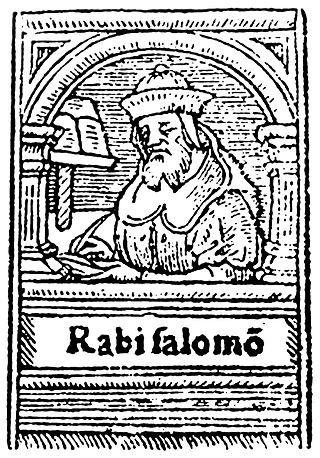
Shlomo Yitzchaki, generally known by the acronym Rashi, was a medieval French rabbi, the author of comprehensive commentaries on the Talmud and Hebrew Bible.

In writing and typography, a ligature occurs where two or more graphemes or letters are joined to form a single glyph. Examples are the characters ⟨æ⟩ and ⟨œ⟩ used in English and French, in which the letters ⟨a⟩ and ⟨e⟩ are joined for the first ligature and the letters ⟨o⟩ and ⟨e⟩ are joined for the second ligature. For stylistic and legibility reasons, ⟨f⟩ and ⟨i⟩ are often merged to create ⟨fi⟩ ; the same is true of ⟨s⟩ and ⟨t⟩ to create ⟨st⟩. The common ampersand, ⟨&⟩, developed from a ligature in which the handwritten Latin letters ⟨e⟩ and ⟨t⟩ were combined.
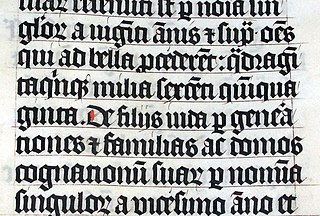
Blackletter, also known as Gothic script, Gothic minuscule or Gothic type, was a script used throughout Western Europe from approximately 1150 until the 17th century. It continued to be commonly used for Danish, Norwegian, and Swedish until the 1870s, Finnish until the turn of the 20th century, Latvian until the 1930s, and for the German language until the 1940s, when Hitler officially discontinued it in 1941. Fraktur is a notable script of this type, and sometimes the entire group of blackletter faces is referred to as Fraktur. Blackletter is sometimes referred to as Old English, but it is not to be confused with the Old English language, which predates blackletter by many centuries and was written in the insular script or in Futhorc. Along with Italic type and Roman type, blackletter served as one of the major typefaces in the history of Western typography.
The Ol Chiki script, also known as Ol Chemetʼ, Ol Ciki, Ol, and sometimes as the Santhali alphabet invented by Pandit Raghunath Murmu in 1925, is the official writing system for Santhali, an Austroasiatic language recognized as an official regional language in India. It is one of the official scripts of the Indian Republic. It has 30 letters, the design of which is intended to evoke natural shapes. The script is written from left to right, and has two styles. Unicode does not maintain a distinction between these two, as is typical for print and cursive variants of a script. In both styles, the script is unicameral.
The shapes of the letters are not arbitrary, but reflect the names for the letters, which are words, usually the names of objects or actions representing conventionalized form in the pictorial shape of the characters.

Jewish languages are the various languages and dialects that developed in Jewish communities in the diaspora. The original Jewish language is Hebrew, supplanted as the primary vernacular by Aramaic following the Babylonian exile. Jewish languages feature a syncretism of Hebrew and Judeo-Aramaic with the languages of the local non-Jewish population.

Aljamiado or Aljamía texts are manuscripts that use the Arabic script for transcribing European languages, especially Romance languages such as Old Spanish or Aragonese. This alphabet is also called the Morisco alphabet.

A tittle or superscript dot is a small distinguishing mark, such as a diacritic in the form of a dot on a letter. The tittle is an integral part of the glyph of i and j, but diacritic dots can appear over other letters in various languages. In most languages, the tittle of i or j is omitted when a diacritic is placed in the tittle's usual position, but not when the diacritic appears elsewhere.
Waw is the sixth letter of the Semitic abjads, including Phoenician wāw 𐤅, Aramaic waw 𐡅, Hebrew vav ו, Syriac waw ܘ and Arabic wāw و.
Aleph is the first letter of the Semitic abjads, including Phoenician ʾālep 𐤀, Hebrew ʾālef א, Aramaic ʾālap 𐡀, Syriac ʾālap̄ ܐ, Arabic ʾalif ا, and North Arabian 𐪑. It also appears as South Arabian 𐩱 and Ge'ez ʾälef አ.
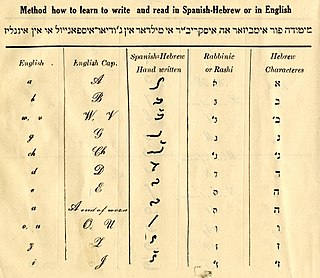
Solitreo is a cursive form of the Hebrew alphabet. Traditionally a Sephardi script, it is the predecessor of modern cursive Hebrew currently used for handwriting in modern Israel and for Yiddish. The two forms differ from each other primarily in that Solitreo uses far more typographic ligatures than the Modern Hebrew script.
Cursive Hebrew is a collective designation for several styles of handwriting the Hebrew alphabet. Modern Hebrew, especially in informal use in Israel, is handwritten with the Ashkenazi cursive script that had developed in Central Europe by the 13th century. This is also a mainstay of handwritten Yiddish. It was preceded by a Sephardi cursive script, known as Solitreo, that is still used for Ladino.

The Latin script is the most widely used alphabetic writing system in the world. It is the standard script of the English language and is often referred to simply as "the alphabet" in English. It is a true alphabet which originated in the 7th century BC in Italy and has changed continually over the last 2,500 years. It has roots in the Semitic alphabet and its offshoot alphabets, the Phoenician, Greek, and Etruscan. The phonetic values of some letters changed, some letters were lost and gained, and several writing styles ("hands") developed. Two such styles, the minuscule and majuscule hands, were combined into one script with alternate forms for the lower and upper case letters. Modern uppercase letters differ only slightly from their classical counterparts, and there are few regional variants.
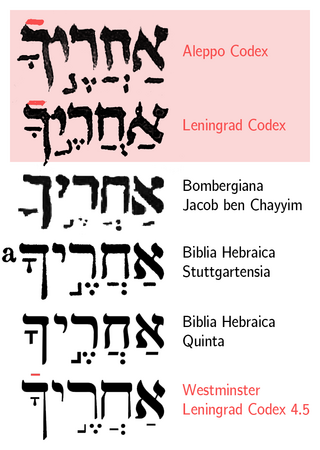
In Hebrew orthography the rafe or raphe is a diacritic, a subtle horizontal overbar placed above certain letters to indicate that they are to be pronounced as fricatives.

Judaeo-Spanish or Judeo-Spanish, also known as Ladino, is a Romance language derived from Old Spanish.
Abraham Garton was a Jewish printer who printed the first dated Hebrew book in Europe in 1475.
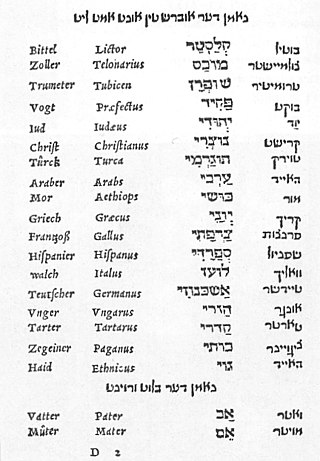
Vaybertaytsh or mashket, is a semi-cursive script typeface for the Yiddish alphabet. From the 16th until the early 19th century, the mashket font distinguished Yiddish publications, whereas Hebrew square script were used for classical texts in Hebrew and Aramaic, and "Rashi" script for rabbinic commentaries and works in Ladino.













